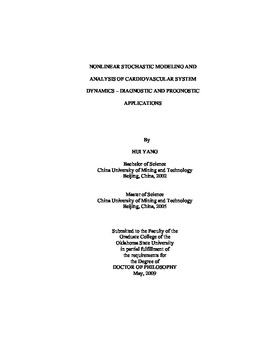| dc.contributor.advisor | Bukkapatnam, Satish T. S. | |
| dc.contributor.advisor | Komanduri, R. | |
| dc.contributor.author | Yang, Hui | |
| dc.date.accessioned | 2013-12-10T18:05:06Z | |
| dc.date.available | 2013-12-10T18:05:06Z | |
| dc.date.issued | 2009-05 | |
| dc.identifier.uri | https://hdl.handle.net/11244/7784 | |
| dc.description.abstract | Scope and Method of Study: | |
| dc.description.abstract | The purpose of this investigation is to develop monitoring, diagnostic and prognostic schemes for cardiovascular diseases by studying the nonlinear stochastic dynamics underlying complex heart system. The employment of a nonlinear stochastic analysis combined with wavelet representations can extract effective cardiovascular features, which will be more sensitive to the pathological dynamics instead of the extraneous noises. While conventional statistical and linear systemic approaches have limitations for capturing signal variations resulting from changes in the cardiovascular system state. The research methodology includes signal representation using optimal wavelet function design, feature extraction using nonlinear recurrence analysis, and local recurrence modeling for state prediction. | |
| dc.description.abstract | Findings and Conclusions: | |
| dc.description.abstract | New representation scheme for the ECG signals by an optimal wavelet function design which yields one order of magnitude compactness reduction compared to the conventional wavelets in terms of entropy. | |
| dc.description.abstract | New spatiotemporal representation scheme for the VCG signals, which significantly assists the interpretation of vectorcardiogram and facilitates the exploration of related important spatiotemporal cardiovascular dynamics. | |
| dc.description.abstract | Developed a classification and regression tree (CART) model to integrate the cardiologists' knowledge towards accurate classification of Atrial Fibrillation (AF) states from sparse datasets. | |
| dc.description.abstract | Developed a Myocardial Infarction (MI) classification model using recurrence quantification analysis and spatial octant features of VCG attractor dynamics, which detects MI up to about 96% accuracy in both sensitivity and specificity. | |
| dc.description.abstract | Designed a local recurrence prediction model for real time medical prognosis and risk assessment of cardiovascular problems, which is particularly suitable for the implementation in the nonlinear and nonstationary environment. | |
| dc.format | application/pdf | |
| dc.language | en_US | |
| dc.rights | Copyright is held by the author who has granted the Oklahoma State University Library the non-exclusive right to share this material in its institutional repository. Contact Digital Library Services at lib-dls@okstate.edu or 405-744-9161 for the permission policy on the use, reproduction or distribution of this material. | |
| dc.title | Nonlinear stochastic modeling and analysis of cardiovascular system dynamics-diagnostic and prognostic applications | |
| dc.contributor.committeeMember | Kolarik, William J. | |
| dc.contributor.committeeMember | Kong, Zhenyu (James) | |
| osu.filename | Yang_okstate_0664D_10167.pdf | |
| osu.accesstype | Open Access | |
| dc.type.genre | Dissertation | |
| dc.type.material | Text | |
| dc.subject.keywords | myocardial infarction | |
| dc.subject.keywords | nonlinear dynamics | |
| dc.subject.keywords | recurrence analysis | |
| dc.subject.keywords | simulation | |
| dc.subject.keywords | vectorcardiogram | |
| dc.subject.keywords | wavelet analysis | |
| thesis.degree.discipline | Industrial Engineering and Management | |
| thesis.degree.grantor | Oklahoma State University | |
